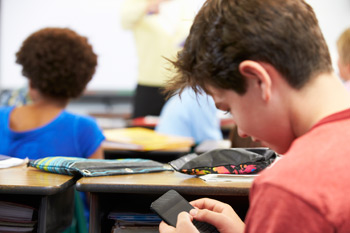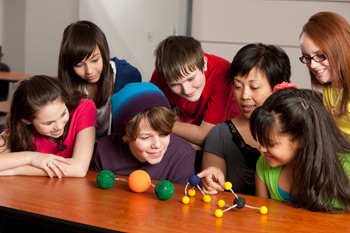Teacher invites Twitter into the classroom
A middle school teacher offers science engagement in 140-character increments

Some schools invite regulated use of smartphones or tablet computers to augment classroom learning. Some schools are also embracing social media.
monkeybusinessimages/ iStockphoto
Explaining a scientific concept in only 140 characters can be almost impossible. But connecting with a researcher or following a big event in the scientific world? That can be just a tweet away.
A middle school teacher has shared how his students use Twitter in the classroom. Each post — or tweet — to this online social network can run no more than 140 characters. But it can be enough for students to engage in meaningful and personalized science experiences.
That said, it’s also best to be prepared for the potential fallout when tween meets screen.
Ryan Becker teaches physical science to eighth graders at Woodstock Union Middle School in Woodstock, Vt. He didn’t discover Twitter until 2011, when he attended a technology conference with a session on using the network to connect with other teachers. “I knew nothing about Twitter or Facebook,” he recalls. “But the description sounded interesting.”
Becker soon realized that he didn’t want to limit Twitter to teachers interacting with other educators. “I thought, ‘Why can’t kids realize all of these uses?’” And to find out, he began incorporating Twitter into his classes.
Becker and Penny Bishop, who studies middle-school education at the University of Vermont in Burlington, have now published a paper on using Twitter in middle-school science. It appeared March 21 in the Middle School Journal.
Getting started
Becker’s school provides all of its students with netbooks. Before letting the kids set up Twitter accounts, Becker sent a carefully-worded letter to each student’s parents. They were given the option of having their child opt out. And while Twitter has no age restrictions, Becker won’t allow any of his students under 13 to sign up.
For kids who do get accounts, Becker makes sure those accounts are protected. By that he means each student has to approve all followers, and his or her tweets will not be visible to people outside that protected-follower list.

“I try to keep it very informal,” he says. “One of my big reasons for using Twitter is that I try to get students to connect science to their own lives.”
When his class learned about eclipses, the students had to look up interesting facts about eclipses, seasons and lunar phases. Then they had to tweet those facts with a link to the source. Hashtags are searchable words or phrases with a “#” sign in front. By including the hashtag #earthmoonsun, Becker could easily find and curate the responses.
In 2014, his class followed along on Twitter as the Philae lander touched down on the surface of the comet 67P/Churyumov-Gerasimenko. “How cool is it to follow [big events in science] by the minute?” he asks. “Kids were tweeting about it — and could tweet to the NASA mission.” Best of all, scientists and the science communicators at NASA sometimes tweeted right back.
Most tweens and teens don’t use Twitter, preferring other social-media networks. Becker says that’s fine with him. “I don’t want to intrude on their territory,” he explains. “So the fact that they don’t use it as much is a positive in my opinion.” And because his class is the reason the kids set up their accounts, Becker feels he has the opportunity to shape how they use the service.
In surveys of his classrooms, 95 percent of Becker’s students felt that Twitter allowed them to follow real science as it happened. And 90 percent felt Twitter had helped them connect science to their personal interests.
Support, with a note of caution
The paper is a useful introduction for teachers who may not have thought about using Twitter in their teaching, says Lali DeRosier. She teaches life science to seventh graders at Holy Trinity Episcopal Academy in Melbourne, Fla. DeRosier uses Twitter herself, both personally and to connect with fellow teachers. “I love the examples of how [Becker] was using it in the classroom,” she says.
But DeRosier also cautions that many teachers may not have an easy time setting up Twitter accounts with their students. “You need to think about who your audience is,” she explains. “This is the time when a lot of parents haven’t allowed their kids to use social media.” In her school, for instance, some parents aren’t even comfortable yet with their children using internet-capable computers.

Becker stresses that his use of Twitter is only in the classroom, and it remains strictly voluntary. Students aren’t graded on whether they tweet. “Usually if I’m asking them to use it I’m giving them time in class,” he notes. “It’s not meant to supplant classroom learning. It’s meant to complement and extend it.”
But teachers will need to be careful that the students who use Twitter in class don’t have their horizons expanded too broadly, says DeRosier. “You have to get approval from your administrators,” she notes. “Schools have little tolerance for scandal. That’s something you need to consider.”
If inappropriate things end up filling students’ feeds, the teachers may pay the price, she warns, because “When things go wrong on the internet, they go catastrophically wrong.” She recalls the case of a high school teacher who was being filmed using Twitter with his class. The hashtag they were using became popular — and pornographic bots quickly found the feed.
“I always worry about content, but I feel like that comes with being an educator,” says Becker. “Anything you can find on Twitter, you’re only one or two clicks away from on Google or YouTube.” He tries to embrace the opportunity to discuss internet behavior — and netiquette — with his students. So far, because he focuses only on tweeting about science, Becker says he hasn’t seen anything to worry about. But, he admits “Kids don’t share everything.”
Follow Eureka! Lab on Twitter
Power Words
(for more about Power Words, click here)
comet A celestial object consisting of a nucleus of ice and dust. When a comet passes near the sun, gas and dust vaporize off the comet’s surface, creating its trailing “tail.”
eclipse The temporary masking of one celestial body (such as the sun or moon) by another passing in front of it (from our vantage point on Earth). An eclipse can be full (or total), where the more distant object totally disappears for a time, or partial, where some part of it remains visible at all times to viewers on Earth.
hashtag A word or phrase with no spaces, prefaced by the “#” sign. Including a hashtag in a message, such as a tweet, provides an identity tag that allows other people to search for and find related messages. This allows readers to find and follow a specific topic or group.
lander A special, small vehicle designed to ferry humans or scientific equipment between a spacecraft and the celestial body they will explore.
media (in the social sciences) A term for the ways information is delivered and shared within a society. It encompasses not only the traditional media — newspapers, magazines, radio and television — but also Internet- and smartphone-based outlets, such as blogs, Twitter, Facebook and more. The newer, digital media are sometimes referred to as social media.
netiquette A term for how to behave appropriately and responsibly on the Internet.
smartphone A cell (or mobile) phone that can perform a host of functions, including search for information on the Internet.
social media Internet-based media, such as Facebook, Twitter and Tumblr, that allow people to connect with each other (often anonymously) and to share information.
social network Communities of people (or animals) that are interrelated owing to the way they relate to each other. In humans, this can involve sharing details of their life and interests on Twitter or Facebook, or perhaps belonging to the same sports team, religious group or school.
tweet Message consisting of 140 or fewer characters that is available to people with an online Twitter account.
Twitter An online social network that allows users to post messages containing no more than 140 characters.